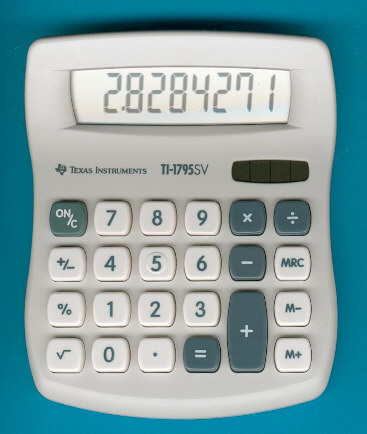
DATAMATH CALCULATOR MUSEUM
 |
DATAMATH CALCULATOR MUSEUM |
Texas Instruments TI-1795SV
| Date of introduction: | 2000 | Display technology: | LCD |
| New price: | Display size: | 8 | |
| Size: | 5.2" x 4.3" x
0.95" 132 x 109 x 24 mm3 |
||
| Weight: | 3.3 ounces, 93 grams | Serial No: | |
| Batteries: | LR54 (30µA) | Date of manufacture: | mth 03 year 2000 (A) |
| AC-Adapter: | Origin of manufacture: | China (N) | |
| Precision: | 8 | Integrated circuits: | |
| Memories: | 1 | ||
| Program steps: | Courtesy of: | Joerg Woerner |

![]()
 This
TI-1795SV looks great - you won't find any right angle in the design. Curious
about the SV designation? It is the abbreviation of SuperViewTM which
implies the perfect size and contrast of the LC-Display. Compare it with its predecessor
TI-1795+
or the TI-508 PLUS.
This
TI-1795SV looks great - you won't find any right angle in the design. Curious
about the SV designation? It is the abbreviation of SuperViewTM which
implies the perfect size and contrast of the LC-Display. Compare it with its predecessor
TI-1795+
or the TI-508 PLUS.



 Dismantling this TI-1795SV
manufactured in March 2000 by Nam Tai
Electronics in China and a second unit from June 2002 reveals a clean design
centered around an unknown single-chip calculator circuit mounted in
Chip-on-Board (COB) technology on a small double-sided printed circuit board
(PCB) and powered by small solar cells and a LR54 (LR1130) backup battery. A
larger, single-sided PCB is used for the keyboard and connected with a short
flat flexible cable (FFC).
Dismantling this TI-1795SV
manufactured in March 2000 by Nam Tai
Electronics in China and a second unit from June 2002 reveals a clean design
centered around an unknown single-chip calculator circuit mounted in
Chip-on-Board (COB) technology on a small double-sided printed circuit board
(PCB) and powered by small solar cells and a LR54 (LR1130) backup battery. A
larger, single-sided PCB is used for the keyboard and connected with a short
flat flexible cable (FFC).

 Inspecting
the PCBs of the two TI-1795SV calculators brought our attention to
two small marks reading
TI-1795SV VS302-1 resp.
TI-1795SV VS307-1. We spotted a very similar pair of PCB-Marks already
with a TI-1795+ manufactured by Nam Tai Electronics and reading
TI-1795NP JP302-2 resp.
TI-1795NP JP307-2. We started compiling a list of the PCB-Marks on calculators
manufactured by OEMs for Texas Instruments.
Inspecting
the PCBs of the two TI-1795SV calculators brought our attention to
two small marks reading
TI-1795SV VS302-1 resp.
TI-1795SV VS307-1. We spotted a very similar pair of PCB-Marks already
with a TI-1795+ manufactured by Nam Tai Electronics and reading
TI-1795NP JP302-2 resp.
TI-1795NP JP307-2. We started compiling a list of the PCB-Marks on calculators
manufactured by OEMs for Texas Instruments.
An identical calculator was sold with the TI-7350SV while the almost identical TI-1796SV features a display with 10 digits capability.
A similar shaped housing was used with the €-1796 introduced in 2000, too.
In 2003 Texas Instruments introduced
with the TI-503SV, TI-1706SV and
TI-1795SV a new design style. These calculators
were optimized in the wind tunnel for best aerodynamics. The TI-1795SV was in 2003 the only calculator that
actually received even a
technical improvement with its new tax functionality.
If you have additions to the above article please email: joerg@datamath.org.
© Joerg Woerner, February 3, 2002. No reprints without written permission.